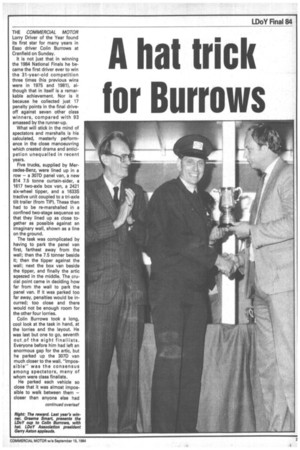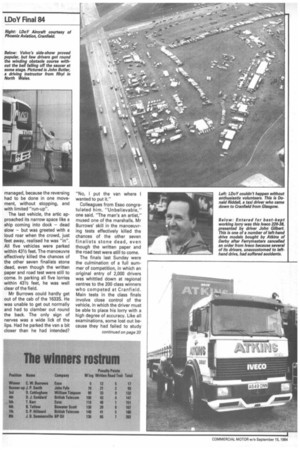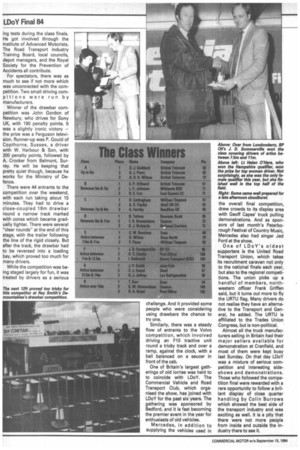A hat trick for Burrows
Page 33

Page 34

Page 37

Page 38

If you've noticed an error in this article please click here to report it so we can fix it.
THE COMMERCIAL MOTOR Lorry Driver of the Year found its first star for many years in Esso driver Colin Burrows at Cranfield on Sunday.
It is not just that in winning the 1984 National Finals he became the first driver ever to win the 31-year-old competition three times (his previous wins were in 1975 and 1981), al though that in itself is a remar kable achievement. Nor is it because he collected just 17 penalty points in the final driveoff against seven other class winners, compared with 93 amassed by the runner-up.
What will stick in the mind of spectators and marshalls is his calculated, masterly performance in the close manoeuvring which created drama and anticipation unequalled in recent years.
Five trucks, supplied by Mercedes-Benz, were lined up in a row — a 307D panel van, a new 814 7.5 tonne curtain-sider, a 1617 two-axle box van, a 2421 six-wheel tipper, and a 1633S tractive unit coupled to a tri-axle tilt trailer (from TIP). These then had to be re-marshalled in a confined two-stage sequence so that they lined up as close to gether as possible against an imaginary wall, shown as a line on the ground.
The task was complicated by having to park the panel van first, farthest away from the wall; then the 7.5 tonner beside it; then the tipper against the wall; next the box van beside the tipper, and finally the artic
sqeezed in the middle. The crucial point came in deciding how
far from the wall to park the panel van. If it was parked too far away, penalties would be incurred; too close and there would not be enough room for the other four lorries.
Colin Burrows took a long, cool look at the task in hand, at the lorries and the layout. He was last but one to go, seventh out of the eight finallists.
Everyone before him had left an enormous gap for the artic, but he parked up the 307D van much closer to the wall. "Impossible" was the consensus among spectators, many of whom were class finalists.
He parked each vehicle so close that it was almost impossible to walk between them — closer than anyone else had managed, because the reversing had to be done in one movement, without stopping, and with limited "run-up".
The last vehicle, the artic approached its narrow space like a ship coming into dock — dead slow — but was greeted with a loud roar when the crowd, just feet away, realised he was "in". All five vehicles were parked within 431/2 feet. The manoeuvre effectively killed the chances of the other seven finalists stone dead, even though the written paper and road test were still to come. In parking all five lorries within 431/2 feet, he was well clear of the field.
Mr Burrows could hardly get out of the cab of the 1633S. He was unable to get out normally and had to clamber out round the back. The only sign of nerves was a wide lick of the lips. Had he parked the van a bit closer than he had intended? "No, I put the van where I wanted to put it."
Colleagues from Esso congratulated him. "Unbelievable," one said. "The man's an artist," mused one of the marshal's. Mr Burrows' skill in the manoeuvring tests effectively killed the chances of the other seven finalists stone dead, even though the written paper and the road test were still to come.
The finals last Sunday were the culmination of a full summer of competition, in which an original entry of 2,000 drivers was whittled down at regional centres to the 200 class winners who competed at Cranfield. Main tests in the class finals involve close control of the vehicle, in which the driver must be able to place his lorry with a high degree of accuracy. Like all examinations, some lost out because they had failed to study the instructions closely, and several did tests wrongly Entrance to LDoY these days is largely limited to major fleet operators — the recession and cost of taking part at LDoY has grown in recent years, but the competition retains a keen competitive edge and a great deal of enthusiasm.
Dave Sedge, for example, of Bowater Scott in Kent, went to East Sussex to qualify because the Kent centre has closed. He was overall winner at East Sussex. He was unable to compete last year and in 1982 after the police found a bald patch on his tyre at 2.30 one morning as he drove home from work.
He normally pulls a singleaxle trailer with the axle at the extreme rear, but came to the competition with an old tandem axle flat. This gave him a better chance in the manoeuvring tests, he said on the eve of competition. It was all to no avail, as he finished in the middle of his class with 141 penalty points. But he'll be back next year.
There are almost as many people needed to run the LDoY competition as there are entrants. Around 2,000 help at the local competitions, and there is a small army at Cranfield. Without them, LDoY couldn't happen. They get involved through a large number of organisations.
Glasgow taxi driver Donald Riddell, for example, was in charge of one of the manoeuvr ing tests during the class finals. He got involved through the Institute of Advanced Motorists. The Road Transport Industry Training Board, local councils, depot managers, and the Royal Society for the Prevention of Accidents all contribute.
For spectators, there was as much to see if not more which was unconnected with the competition. Two small driving cornpitions were run by manufacturers.
Winner of the drawbar competition was John Gordon of Newbury, who drives for Sony UK, with 190 penalty points. It was a slightly ironic victory — the prize was a Ferguson television. Runner-up was P. Gould of Copthorne, Sussex, a driver with W. Harbour & Son, with 200 penalty points, followed by A. Crocker from Belmont, Surrey. He will be keeping that pretty quiet though, because he works for the Ministry of Defence.
There were 44 entrants to the competition over the weekend, with each run taking about 15 minutes. They had to drive a close-coupled 18m drawbar round a narrow track marked with cones which became gradually tighter. There were several "clear rounds" at the end of this stage, with the trailer following the line of the rigid closely. But after the track, the drawbar had to be reversed into a loading bay, which proved too much for many drivers.
While the competition was being staged largely for fun, it was treated by drivers as a serious challenge. And it provided some people who were considering using drawbars the chance to try one.
Similarly, there was a steady flow of entrants to the Volvo competition, which involved driving an F10 tractive unit round a tricky track and over a ramp, against the clock, with a ball balanced on a saucer in front of the cab.
One of Britain's largest gatherings of old lorries was held to to coincide with LDoY. The Commercial Vehicle and Road Transport Club, which organised the show, has joined with LDoY for the past six years. The gathering was sponsored by Bedford, and it is fast becoming the premier event in the year for enthusiasts of old vehicles.
Mercedes, in addition to supplying the vehicles used in the overall final competition, drew crowds to its display area with Geoff Capes' truck pulling demonstrations. And as sponsors of last month's Peterborough Festival of Country Music, Mercedes also had singer Jed Ford at the show.
One of LDoY's oldest supporters is the United Road Transport Union, which takes its recruitment caravan not only to the national finals each year, but also to the regional competitions. The union picks up a handful of members, northwestern officer Frank Griffen said, but it turns out more to fly the URTU flag. Many drivers do not realise they have an alternative to the Transport and Gen eral, he added. The URTU is affiliated to the Trades Union Congress, but is non-political.
Almost all the truck manufacturers selling in Britain had their major sellers available for demonstration at Cranfield, and most of them were kept busy last Sunday. On that day LDoY was a mixture of serious competition and interesting sideshows and demonstrations. Those who followed the competition final were rewarded with a rare opportunity to follow a brillant display of close quarter handling by Cohn Burrows which showed the best side of the transport industry and was exciting as well. It is a pity that there were not more people from inside and outside the industry there to see it.






























































































